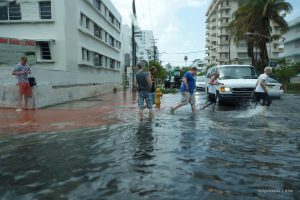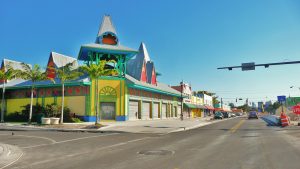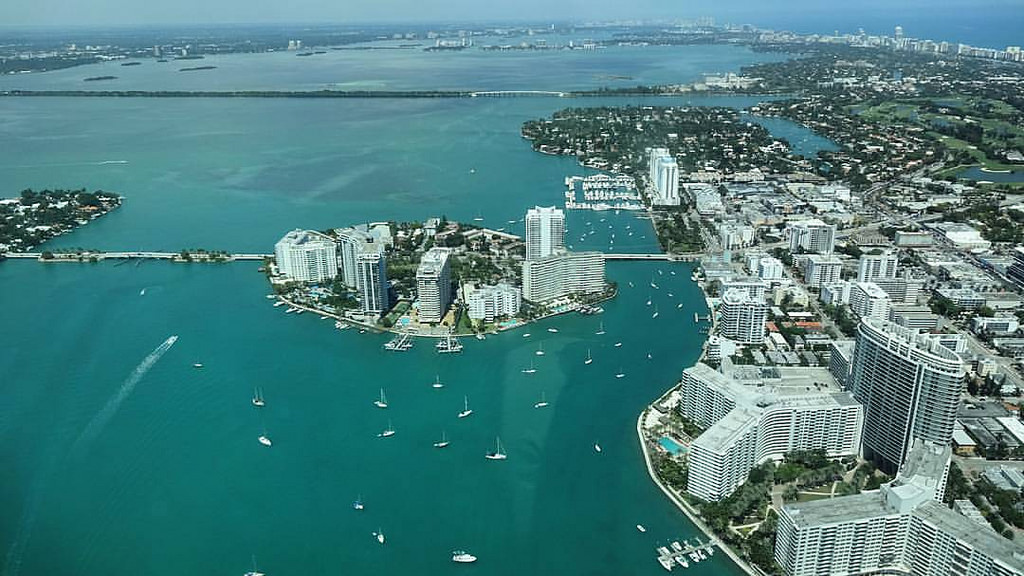A particular irony is unfolding in Miami.
Real estate along the city’s shorelines has traditionally attracted many of Miami’s wealthiest residents and developers, while mainland neighborhoods lying farthest from the beach—often on higher elevations—have been among Miami’s most affordable. Rising sea levels are projected to invert this value proposition.

In other words, the prospect of being submerged under rising seas or simply being stuck in water-clogged traffic is partially attributed to causing some resident beachcombers to move inland and real-estate prices to move upward. This phenomenon is of multi-faceted interest to the Harvard Graduate School of Design’s Jesse M. Keenan, lecturer in architecture and urban development, whose work and research have focused heavily on both real estate development and climate change adaptation.
“To be on the beach and to be on the water costs a lot more money, and the cheaper parts of town were furthest from the beach—but it just turns out that the cheapest parts of town farthest from the beach are the highest elevation, and now they’re worth a lot more than they used to be,” Keenan tells Scientific American. (See also his recent interview with Vice on the issue.)
There is emerging evidence that is beginning to support a theory of economic adaptation that Keenan has coined “climate gentrification.” The basic idea is that substitute investments in less vulnerable or highly resilient urban areas will operate to accelerate speculative investment, fueling gentrification and displacement. As the impacts of climate change drive people away from afflicted areas, these residents relocate to—and gentrify—less-vulnerable neighborhoods.
In some cases, such as Copenhagen, resilience investments have led to a type of gentrification that has forced out the very residents that the investments were intended to protect.
Miami has surfaced frequently as a case study in climate change, but this intersection between rising seas and the long-standing questions of affordable housing, environmental justice, and infrastructure investment make the region unique. So is the opportunity—and the challenge—of studying it.
“Our work in climate gentrification highlights the cross-disciplinary nature of climate adaptation research at the GSD in that we have planning, landscape, real estate, and risk and resilience students and faculty converging on critical issues,” Keenan notes. “Research and teaching in climate adaptation and resilience operates across scales from material science to regional ecology and from household budgets to portfolio investment strategies of institutional investors.”
Various mainland Miami neighborhoods like Little Haiti, Liberty City, and Allapattah have historically been home to some of Miami’s most culturally vibrant—and most vulnerable—communities. Nestled atop a coral ridge, these communities offer unique case studies as their newly “hot” and “up-and-coming” neighborhoods continue down a path of gentrification. Keenan’s ongoing research aims to study how much of this gentrification and attendant effects are tied to behaviors that can be partially explained by risk aversion to climate change and extreme weather.

The most immediate drivers are infill development and affordable housing, but Keenan assumes a certain inevitability to the up-zoning of density on high-elevation property.
To put it another way: will residents of Miami-Dade County’s coast—wary of rising seas, nuisance flooding and increasing property tax burdens—push inland and drive out long-time residents of neighborhoods like Little Haiti? Will resilient high density urban development accommodate internal climate migrants? What are the implications for a tax base and the bonding capacity of the various municipalities? As Keenan noted in an interview with Bloomberg News, “this evokes matters of equity and justice that have very limited historical precedent.”
Among other roles and honors, Keenan has served as the Vice-Chair for the U.S. Community Resilience Panel (under two presidential administrations) and has been nominated to be the panel’s incoming Chair this fall. He is also editorial team co-lead for the Built Environment at the U.S. Climate Resilience Toolkit at climate.gov and has served in a variety of capacities with the federal government, various global cities and the Intergovernmental Panel on Climate Change (IPCC) where his unique focus has been on adaptation and the built environment.
In addition to these roles and his teaching, Keenan recently published the books Climate Change Adaptation in North America: Fostering Resilience and the Regional Capacity to Adapt (co-edited with Leal Filho) and Blue Dunes: Climate Change by Design (co-edited with Claire Weisz).
This fall, Keenan will assume co-directorship of the Master in Design Studies program’s Real Estate and the Built Environment concentration, and will be teaching the courses Sustainable Real Estate and Foundations of Practice at the GSD, followed by his reoccurring course Resilience and Adaptation Science in the spring—all while keeping a research-minded eye on the emerging popular discourse shaping climate gentrification.
“Climate gentrification is a phenomenon that will not be limited to steering residential patterns along the coast,” Keenan observes. “It will directly impact the ranges of flora and fauna, it will dictate the capital flows of real estate investment, it will engender a new form of architecture, and it will rewrite the boundaries of political and cultural geography.”
